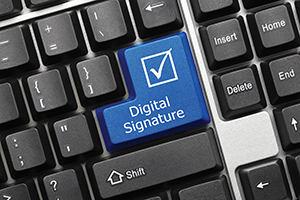Invisible government

Siim Sikkut digital policy adviser to the Estonian Prime Minister and Government talks to Owen McQuade about e-Estonia and the use of digital signatures in delivering online public services.
Estonia is a leader in digital government and “is sometimes called e-Estonia, because we love technology as citizens and as public servants.” The Estonian government has been developing its digital services for 15 years now and is recognised as a world leader in delivering public services online. “We have seen how IT can make our lives more efficient and more comfortable,” says Siim Sikkut.
When asked why did Estonia decide to go completely digital, he replies: “We had been keen to put in place the infrastructure and platforms that enabled everyone to be more digital in their own fields, particularly the digital identity and the things that everyone needs so you can focus on the needs at your end by building on these platforms.”
Being a small country helped with the transformation to digital: “It meant we had constrained finances, so moving to a shared platform was a necessity as we didn’t have the money to build silo systems in all areas.”
Digital services
Sikkut’s first example of digital services is a touch exotic. He says that saunas are a feature of life in Estonia because of the Baltic climate. “Saunas are important and is somewhere we talk business. If you have a new business idea you can go online from the sauna and get a company up and running with no red tape – you can sort out payroll, banking, paying taxes and other services online. “As a business person, we want you to run your company and not spend time dealing with us in government.”
In Estonia parents can monitor their children’s progress in school online. “If they skip class the parents get a text message – the kids don’t like that but the parents love it.”
If someone has an accident in Estonia, treatment in hospital is aided by the existence of an electronic medical record for all citizens. Estonia has spent the last eight years putting all health records online. “This speeds up treatment and clinicians don’t have to wait to find out your blood type,” says Sikkut.
A simpler healthcare example is the automation of repeat prescriptions with a phone call to the doctor and the medicines waiting at the pharmacy with GPs time freed up.
Digital government spans all aspects pf public services. At the last election, one third of the votes were cast online from 16 countries around the world. The police force has given all patrols real time access to all their online databases. Within a few months the number of stolen cars being located increased by 50 per cent.
Digital signature
The use of a digital signature has been the single biggest thing in providing effective digital public services. Estonia has been using digital signatures for 14 years and “it is the key to accessing public services online.” The digital signature not only allows access but it also authenticates any transaction. For business people it is particularly useful for signing contracts without having to meet.
 Sikkut gives a demonstration of using his digital signature. He can name any file in any format and then give it a digital signature. He first signs into the portal with a PIN for authentication – four digits. He then has another PIN that allows a transaction to happen legally and this has five digits. If the PIN matched that held with his ID the documents are then signed. “It takes longer to explain how to do it than to actually do it,” he observes.
Sikkut gives a demonstration of using his digital signature. He can name any file in any format and then give it a digital signature. He first signs into the portal with a PIN for authentication – four digits. He then has another PIN that allows a transaction to happen legally and this has five digits. If the PIN matched that held with his ID the documents are then signed. “It takes longer to explain how to do it than to actually do it,” he observes.
With any transaction with government in Estonia you now do not have to be present, “perhaps with only marriage,” he quips. This saves an estimated two per cent of GDP each year.
Looking at the technology behind services delivery, Estonia has built a country-wide secure data exchange for use by public service bodies. If any agency needs to send or receive data to another agency they use the joint platform. The connections are activated on a need to know basis and any agency only gets access to agreed data. For example, the police will not have access to health records and they see only the data that they need to. It allows the IT departments in agencies to focus on their own individual service areas.
Like many countries Estonia now has its tax services online. However, filling in an online tax return in Estonia only takes minutes as the online declaration comes filled in, using data from the central platform. “It is about connecting the silos at the back end,” he observes. Next year Sikkut says that declarations will be filed automatically with taxpayers receiving a text telling them the outcomes of the declaration and only if they want to review the declaration do they need to go online.
However, having a shared platform does not mean everything is in one place. Estonia’s government agencies and IT systems are independent of each other. There is no single point that all the data flows through. This makes the overall system very resilient as there are many nodes.
Sikkut says that political leadership is key to implementing digital government, as is a good policy foundation. Estonia has prioritised digital government politically. “Technology wise we are all the same in the world, perhaps the price of the technology varies. What differs is how we use the technology to redesign how we do things.”
“Change management in the public sector is really about leadership and the governance around the transformation process. We have always had a top down support while at the same time everyone is responsible for their own area – it’s a bottom-up meets top-down approach.”
Future
Looking forward to the next phase, Sikkut says the focus is on automating public services: “Firstly, we see lots of ways to make transaction services, which are the bulk of government services, even more efficient, even more efficient for people – that’s our invisible government programme. It’s about making things happen before they come to us with a request by automating many things in the back end.”
The Invisible Government programme is the next phase of digital government: “Most transactions, we know what they are and we don’t need sophisticated analytics to tell us what services citizens will need. For example, if you are 63, you will retire and 99.9 per cent will ask government for a pension. We make them make an application rather than just send them the money. If a child is born, government knows this before the child is named. The hospital registers the new arrival and it is given a number. We know the next steps from naming the child to booking a place in kindergarten,” observes Sikkut.
Other developments includes the delivery of cross-country services. “We would like to develop services with other countries across borders,” adds Sikkut.
Another area that shows future potential is e-residence. “We are looking to see how we can offer more services to foreign users and not just our own citizens. We see this as a revenue stream for the companies that provide services to our own citizens,” concludes Sikkut.

